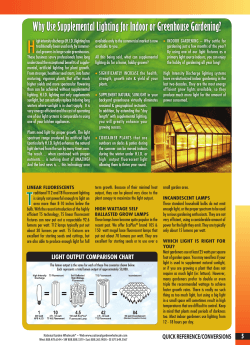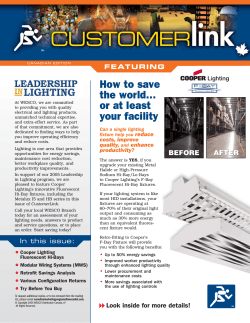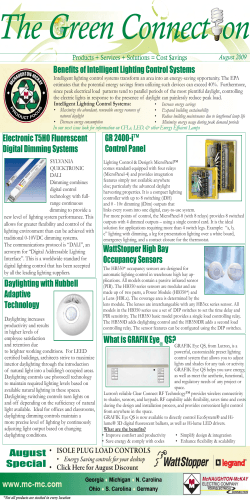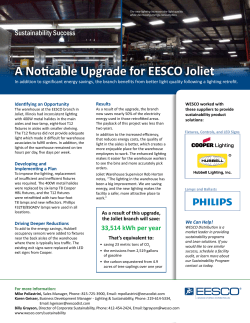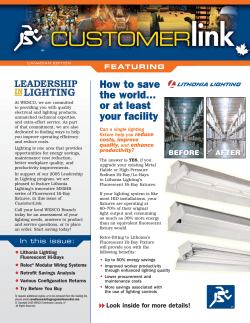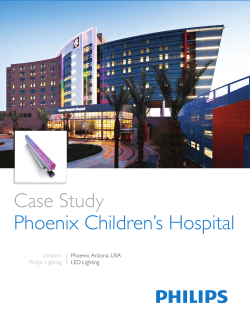
Energy Efficient Lighting
Energy Efficient Lighting Electric lighting is a major energy consumer. Enormous energy savings are possible using energy efficient equipment, effective controls, and careful design. Using less electric lighting reduces heat gain, thus saving air-conditioning energy and improving thermal comfort. Electric lighting design also strongly affects visual performance and visual comfort by aiming to maintain adequate and appropriate illumination while controlling reflection and glare. Lighting is not just a high priority when considering hotel design; it is also a highreturn, low-risk investment. By installing new lighting technologies, hotels can reduce the amount of electricity consumed and energy costs associated with lighting. There are several types of energy efficient lighting and affordable lighting technology. The following are a few examples of energy-saving opportunities with efficient lighting. 1. INSTALLATION OF COMPACT FLUORESCENT LAMPS (CFLS) IN PLACE OF INCANDESCENT LAMPS. Compact Fluorescent Lamps use a different, more advanced technology than incandescent light bulbs and come in a range of styles and sizes based on brand and purpose. They can replace regular, incandescent bulbs in almost any light fixture including globe lamps for the bathroom vanity, lamps for recessed lighting, dimming, and 3-way functionality lights. CFLs use about 2/3 less energy than standard incandescent bulbs, give the same amount of light, and can last 6 to 10 times longer. CFL prices range from $4 to $15 depending on the bulb, but you save about $25 to $30 per bulb on energy during the lifetime of the bulb. When looking to purchase CFLs in place of incandescent bulbs, compare the light output, or Lumens, and not the watts. Watts refers to the amount of energy used, not the amount of light. In other words, if the incandescent bulb you wish to replace is 60 Watts, this is equal to 800 Lumens. To get the same amount of light in a CFL, you should look to find a CFL that provides 800 Lumens or more (equal to about a 13 watt fluorescent bulb). Use the table below to easily figure the conversions. Incandescent Bulb (Watts) Typical Lumens (Measure of Light Output) 40 > 450 60 >800 75 >1100 100 >1600 150 >2600 1 2. INSTALLATION OF ENERGY-EFFICIENT FLUORESCENT LAMPS IN PLACE OF “CONVENTIONAL” FLUORESCENT LAMPS. Many lodging facilities may already use fluorescent lighting in their high traffic areas such as the lobby or office area. However, not all fluorescent lamps are energy efficient and cost effective. There are several types of fluorescent lamps that vary depending on the duration of their lamp life, energy efficiency, regulated power, and the quality of color it transmits. There are a few styles worth noting; these models are simply labeled as “T-12”, “T-8”, or “T-5”. The names come from the size of their diameter per eighth inch. For example, a T-12 lamp is 12/8 inch in diameter (or 1 1/2 inch); a T-8 lamp is 8/8 inch in diameter (or 1 inch); a T-5 lamp is 5/8 inch in diameter. This is a simple way to identify the type of fluorescent lamps your facility is using. Fluorescent lamps are categorized according to their diameter. The recommended style of fluorescent lighting is a T-8. T-8 lights are the most costeffective. They usually cost about $0.99 a bulb and are 30% to 40% more efficient than standard T-12 fluorescent lamps, which have poor color rendition and cause eye strain. T-8 lamps provide more illumination, better color, and don't flicker (often exhibited by standard fluorescent fixtures). T-5 lamps are the most energy efficient and also tend to transmit the best color; however, they usually cost about $5.00 per bulb. Each style of fluorescent lamp cannot function without a ballast. A ballast is an electrical device used in fluorescent lamps to regulate starting and operating characteristics of the lamp. Some ballasts are magnetic where as others are electronic. Electronic high frequency ballasts are now standard for most fluorescent lights. Due to the differences in wattage between the types of lights, if converting from a T-12 to a T-8 light, one must also change the type of ballast being used. Note: It is important to discard all styles of fluorescent lamps appropriately. Because they contain a small amount of mercury, improper disposal could harm our soils or lakes. Fluorescent bulbs should be recycled, not thrown away. 2 3. INSTALLATION OF OCCUPANCY/MOTION SENSORS TO TURN LIGHTS ON AND OFF WHERE APPROPRIATE. Lighting can be controlled by occupancy sensors to allow operation whenever someone is within the area being scanned. When motion can no longer be detected, the lights shut off. Passive infrared sensors react to changes in heat, such as the pattern created by a moving person. The control must have an unobstructed view of the building area being scanned. Doors, partitions, stairways, etc. will block motion detection and reduce its effectiveness. The best applications for passive infrared occupancy sensors are open spaces with a clear view of the area being scanned. Ultrasonic sensors transmit sound above the range of human hearing and monitor the time it takes for the sound waves to return. A break in the pattern caused by any motion in the area triggers the control. Ultrasonic sensors can see around obstructions and are best for areas with cabinets and shelving, restrooms, and open areas requiring 360-degree coverage. Ultrasonic sensor (ceiling mount) Passive Infrared Occupancy Sensor (replaces wall switch) Some occupancy sensors utilize both passive infrared and ultrasonic technology, but are usually more expensive. They can be used to control one lamp, one fixture or many fixtures. The table below provides typical savings achievable for specific building areas, as determined by EPA studies, with the average savings being 60%. 3 4. USE AN AUTOMATED DEVICE, SUCH AS A KEY TAG SYSTEM, TO REGULATE THE ELECTRIC POWER IN A ROOM. The key tag system uses a master switch at the entrance of each guest room, requiring the use of a room key-card to activate them. Using this technique, only occupied rooms consume energy because most electrical appliances are switched off when the keycard is removed (when the guest leaves the room). Along with lighting, the heating, airconditioning, radio and television may also be connected to the master switch. This innovation has a potential savings of about $105.00 per room per year. 5. OFFER NIGHTLIGHTS TO PREVENT THE BATHROOM LIGHTS FROM BEING LEFT ON ALL NIGHT. Many guests opt to have a light on while they sleep. By turning the bathroom light on and leaving the bathroom door cracked open, guests are able to find their way through an unknown room in the middle of the night. Those who are accompanied by children may often do the same to comfort their child. By offering a nightlight, the energy used to power a bathroom light during the nighttime can be avoided and guests will still be able to feel comfortable in unfamiliar territory. One particular model uses six Light Emitting Diodes (LEDs) in the panel of a light switch to provide light for guests. LEDs are just tiny light bulbs that fit easily into an electrical circuit. They are different from ordinary incandescent bulbs because they don’t burn out or get really hot. They are often used in digital clocks or remote controls. 6. REPLACE ALL EXIT SIGNS WITH LIGHT EMITTING DIODE (LED) EXIT SIGNS. The development of light emitting diodes (LEDs) has allowed the replacement of exit sign lighting with a more energy efficient alternative. Multiple LEDs, properly configured, produce equivalent lighting and consume 95% less electricity than incandescent bulbs and 75% less than energy-efficient compact fluorescent lamps. A major benefit is the 20-year life cycle rating of LEDs; they virtually eliminate maintenance. EXIT signs can be Of the three different styles of exit signs, incandescent signs are either green or red the least expensive, but are inefficient and use energy releasing heat instead of light. Fluorescent signs are also inexpensive and have an expected life of about 10,000 hours. LED exit signs are the most expensive, but are also the most efficient exit signs available. Their pay back time is usually about four years. The table on the following page offers an easy comparison of the three models of exit signs. 4 Incandescent Fluorescent LED Input Power (watts) 40 11 2 Yearly energy (kWh) 350 96 18 Lamp life (years) 0.25-0.5 1-2 10+ Estimated energy cost/ year ($0.06/kWh) $21.00 $5.75 $1.10 Note: Not all LED exit signs are the same. Some are of lower quality and decrease their light output after a few years. Be sure to look for LED signs with semiconductor material that is made of aluminum, indium, gallium, and phosphor. Also, some LED signs have lights that are wired in a series circuit, meaning that when one LED light burns out, the whole sign loses its light. Look for LED exit signs that are wired in a parallel circuit. 7. USE HIGH EFFICIENCY (HID) EXTERIOR LIGHTING High intensity discharge (HID) lighting is much more efficient and preferable to incandescent, quartz-halogen and most fluorescent light fixtures. HID types (from least to most efficient) include mercury vapor, metal halide and high pressure sodium. Mercury vapor is seldom used anymore. Both metal halide and high pressure sodium are excellent outdoor lighting systems. High pressure sodium has a pink-orange glow and is used when good color rendition isn’t critical. Metal halide, though less efficient, provides clean white light and good color rendition. HID lighting is mostly utilized in floodlight, wall pack, canopy, post lantern and area fixtures outdoors. The best type for any application depends on the area being lit and mounting options. Floodlight Canopy Fixtures Area Light Wall-Pack Fixture Post Lantern Post Globe 5 8. ADD LIGHTING CONTROLS SUCH AS PHOTO SENSORS OR TIME CLOCKS Photo sensor controls monitor daylight conditions and allow fixtures to operate only when needed. Photo sensors detect the quantity of light and send a signal to a main controller to adjust the lighting. Photo sensors are commonly used with outdoor lighting to automatically turn lights on at dusk and off at dawn, a very cost-effective control device. This helps to lower energy costs by ensuring that unnecessary lighting is not left on during daytime hours. Photo sensors can be used indoors, as well. Building areas with lots of windows may not require lights to be on all of the time. Photocells can be used to ensure fixtures operate only when the natural light is inadequate by either controlling one light fixture, or a group of lights. The table below demonstrates the costsavings from day light controls. Time controls save energy by reducing lighting time of use through preprogrammed scheduling. Time clock equipment ranges from simple devices designed to control a single electrical load to sophisticated systems that control several lighting zones. They are one of the simplest, least expensive, and most efficient energy management devices available. Time controls could include: Simple time switches: automatically turn lights, fans or other electronic devices off after a pre-set time. Multi-channel time controls: have the ability to control from 4 to 16 duties. Special-purpose time controls: include cycle timers for repetitive short duration cycling of equipment or outdoor lighting time controls that combine time clock and photo sensor technologies. 6 9. Resources for Energy Efficient Lighting • ENERGY STAR® Lighting: Provides information on energy efficient lighting and products. http://www.energystar.gov/index.cfm?c=lighting.pr_lighting • Earth Easy: Provides general information on CFLs and LED. http://eartheasy.com/live_energyeff_lighting.htm • US Department of Energy: Technology fact sheet on efficient lighting strategies. http://www.eere.energy.gov/buildings/documents/pdfs/26467.pdf 7
© Copyright 2025

